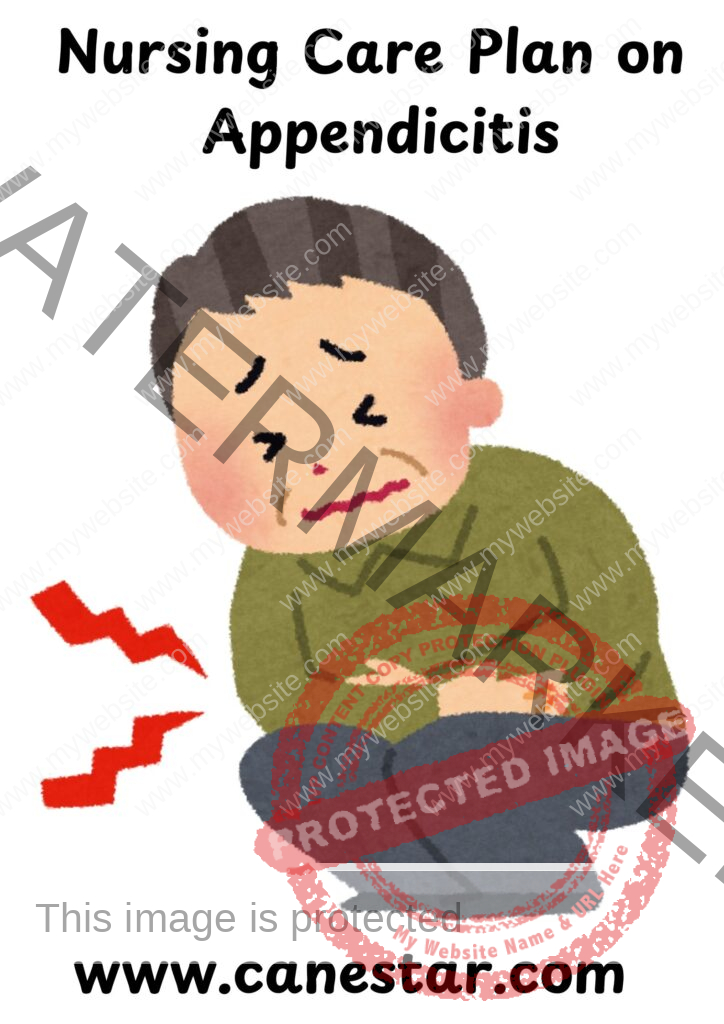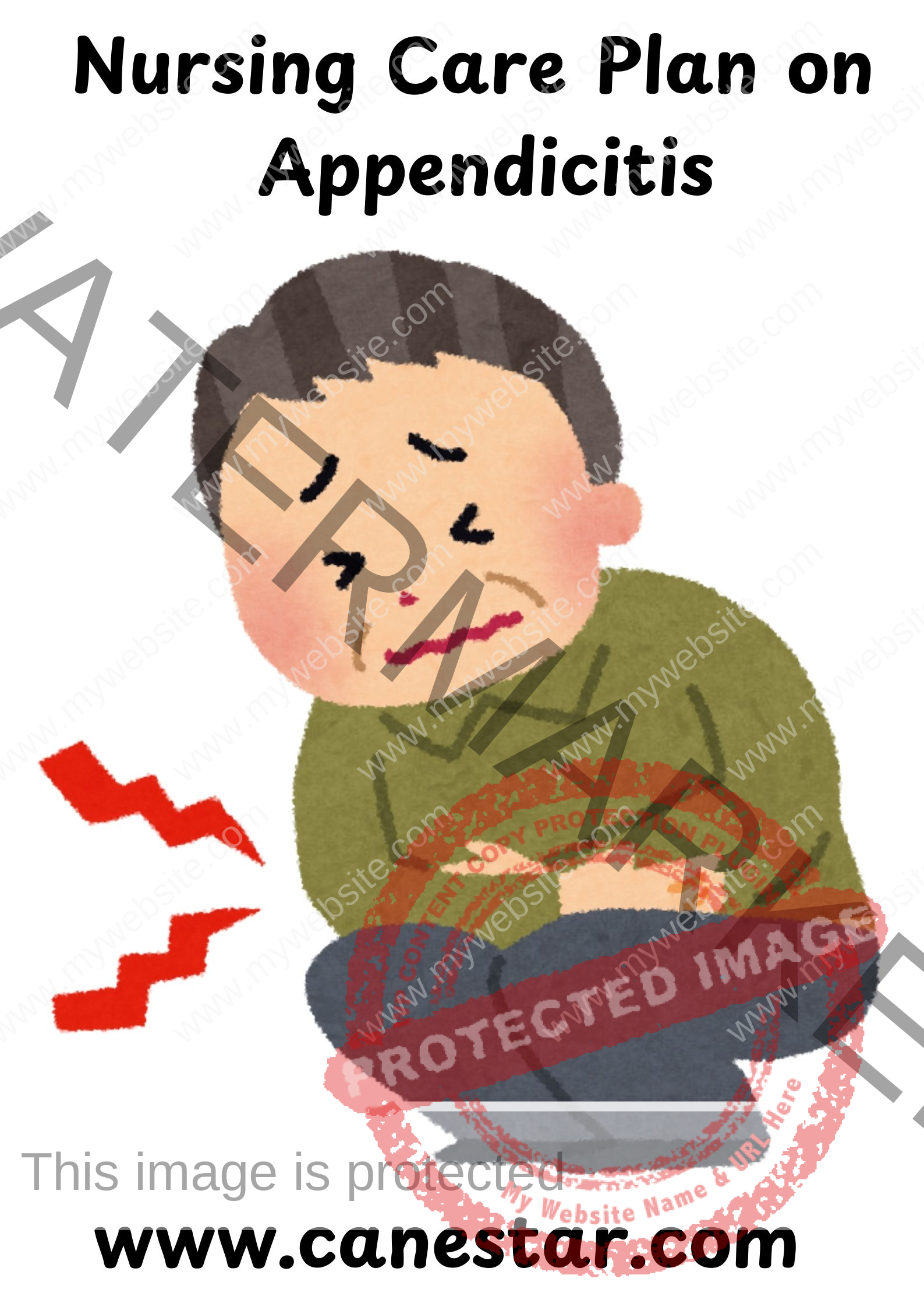NURSING CARE PLAN FOR APPENDICITIS
NURSING CARE PLAN FOR APPENDICITIS
NURSING CARE PLAN ON APPENDICITIS
Appendicitis is the inflammation of the appendix, a small, finger-like pouch attached to the large intestine. It’s a medical emergency that typically requires prompt surgical removal of the appendix. Here’s a quick overview:
Etiology (Causes):
- Blockage of the appendix, often due to fecaliths (hardened stool), lymphoid hyperplasia, or infections.
- Infections may include gastrointestinal viral or bacterial infections leading to inflammation.
Pathophysiology:
- Blockage causes increased pressure within the appendix, reduced blood flow, and bacterial overgrowth, leading to inflammation and infection.
- If untreated, it may rupture, causing peritonitis (infection of the abdominal lining) or abscess formation.
Clinical Manifestations:
- Abdominal pain: Initially diffuse around the umbilicus, then localizes to the right lower quadrant (McBurney’s point).
- Rebound tenderness: Pain upon release of pressure on the abdomen.
- Nausea and vomiting.
- Low-grade fever.
- Loss of appetite.
- Elevated white blood cell count (leukocytosis).
Diagnosis:
- Clinical examination: Based on symptoms and physical exam.
- Imaging: Ultrasound, CT scan to confirm inflammation or rupture.
- Laboratory tests: Elevated WBC count.
Treatment:
- Surgical removal (appendectomy): Laparoscopic or open surgery.
- Antibiotics: Pre- and post-surgery to prevent or treat infection.
Complications:
- Ruptured appendix: Leads to peritonitis, a severe infection of the abdominal cavity.
- Abscess formation: Collection of pus.
NURSING CARE PLAN FOR APPENDICITIS
Nursing Diagnosis 1: Acute Pain related to inflammation and infection of the appendix.
Goal: To reduce pain and ensure comfort for the patient.
Interventions:
- Assess pain using a pain scale (0–10) to determine the intensity and location.
- Positioning: Encourage the patient to lie in a semi-Fowler’s position to reduce abdominal pressure and improve comfort.
- Administer analgesics as prescribed, ensuring timely administration for pain relief.
- Provide comfort measures: Apply a cold pack to the right lower quadrant (avoid heat, as it may lead to rupture).
- Monitor vital signs, especially for tachycardia or increased temperature that may indicate worsening inflammation or infection.
- Instruct the patient to avoid movements that could increase pain (e.g., bending or lifting).
Expected Outcome:
- The patient will report a decrease in pain to a tolerable level, as indicated by a pain score of ≤3 on a scale of 0–10.
Nursing Diagnosis 2: Risk for Infection related to inflammation of the appendix and possible rupture.
Goal: To prevent infection or minimize its effects if it occurs.
Interventions:
- Monitor for signs of infection, such as increased temperature, tachycardia, or changes in mental status.
- Monitor WBC count for signs of infection or sepsis.
- Administer antibiotics as prescribed to prevent or treat infection.
- Prepare the patient for appendectomy to remove the source of infection.
- Provide sterile dressing care post-surgery and educate the patient on wound care to prevent infection at the incision site.
Expected Outcome:
- The patient will show no signs of infection as evidenced by normal vital signs and WBC count.
Nursing Diagnosis 3: Risk for Deficient Fluid Volume related to vomiting, fever, and possible fluid loss due to surgery.
Goal: To maintain fluid balance and prevent dehydration.
Interventions:
- Monitor fluid intake and output (I&O) to assess hydration status.
- Assess for signs of dehydration: dry mucous membranes, decreased skin turgor, and low urine output.
- Administer IV fluids as ordered to maintain fluid balance, particularly before and after surgery.
- Monitor vital signs, including blood pressure and heart rate, for signs of fluid imbalance.
- Encourage oral fluids when the patient is no longer NPO (nothing by mouth), if tolerated.
Expected Outcome:
- The patient will maintain fluid balance, with normal vital signs and adequate urine output.
Nursing Diagnosis 4: Knowledge Deficit related to lack of understanding of the surgical procedure, post-operative care, and recovery.
Goal: To provide adequate education about appendicitis, its treatment, and the post-operative recovery process.
Interventions:
- Educate the patient and family about appendicitis, including causes, symptoms, and the need for surgery.
- Explain the appendectomy procedure and expected recovery process.
- Teach wound care techniques, emphasizing the importance of keeping the incision clean and dry.
- Instruct on signs of infection to watch for post-surgery, such as increased redness, swelling, or drainage from the incision.
- Provide information on diet: Recommend a gradual return to normal eating, starting with clear fluids and progressing to a regular diet as tolerated.
- Advise the patient to avoid strenuous activity for at least 2-4 weeks after surgery.
Expected Outcome:
- The patient will verbalize understanding of appendicitis, surgical treatment, and post-operative care.
Nursing Diagnosis 5: Impaired Physical Mobility related to abdominal pain and post-surgical discomfort.
Goal: To improve mobility while minimizing discomfort.
Interventions:
- Encourage early ambulation post-operatively to prevent complications such as deep vein thrombosis (DVT) and pneumonia.
- Assist the patient with ambulation and activities of daily living (ADLs) as needed.
- Provide analgesics before ambulation to minimize pain during movement.
- Teach the patient how to use abdominal support or splinting (with a pillow) when moving or coughing to reduce discomfort.
- Gradually increase activity levels as tolerated, while avoiding heavy lifting or straining.
Expected Outcome:
- The patient will demonstrate increased physical activity with minimal pain or discomfort.


